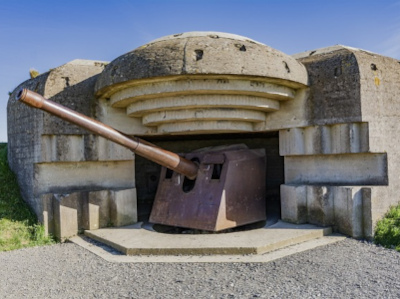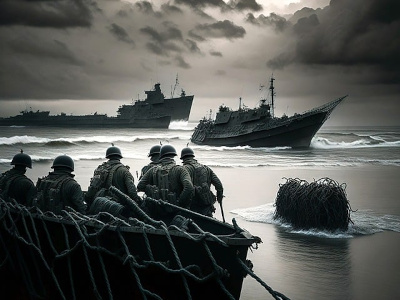D-Day was the name given to the invasion on June 6th, 1944, when troops from the United States, Canada, and the United Kingdom invaded Normandy in northern France during World War II.
Germany invaded and took control of northwestern France in May 1940. By 1942, both the Americans and the British were considering a possible large-scale Allied invasion across the English Channel. The next year, plans for a cross-channel invasion by the Allies began to increase. In November 1943, Adolf Hitler, who knew about the threat of an invasion along the northern coast of France, appointed Erwin Rommel to lead defense operations in the region, even though the Germans were unsure of the exact location where the Allies would strike. Hitler tasked Rommel with completing the Atlantic Wall, a 2,400-mile fortification consisting of bunkers, landmines, and obstacles on the beaches and in the water.
In January 1944, General Dwight Eisenhower became the commander of Operation Overlord, which was the codename for the amphibious assault. Before D-Day, the Allies tricked the Germans by making them think the main invasion target was Pas-de-Calais, not Normandy. They also made the Germans believe Norway and other places could be targets. Deception tactics included fake equipment, a fake army led by George Patton in England, double agents, and fake radio messages.
On June 5, 1944, Eisenhower chose the date for the invasion, but bad weather caused a 24-hour delay. The next day, after the meteorologist predicted better conditions, Eisenhower approved Operation Overlord. He encouraged the troops, saying, “You are about to embark upon the Great Crusade, toward which we have striven these many months. The eyes of the world are upon you.” Later that day, over 5,000 ships and landing craft with troops and supplies departed England for France, with more than 11,000 aircraft providing air cover and support.
By the morning of June 6, thousands of paratroopers and glider troops were already on the ground behind enemy lines, securing bridges and exit roads. The amphibious invasions began at 6:30 a.m. The British and Canadians captured beaches codenamed Gold, Juno, and Sword with little opposition, while the Americans took Utah Beach. U.S. forces faced heavy resistance at Omaha Beach, resulting in over 2,000 American casualties. However, by the end of the day, around 156,000 Allied troops had successfully stormed Normandy’s beaches. Less than a week later, on June 11, the beaches were fully secured.
The Germans faced confusion in the ranks and the absence of celebrated commander Rommel, who was on leave. Initially, Hitler believed the invasion was a diversion to distract from an attack north of the Seine River, so he hesitated to release nearby divisions for a counterattack. Reinforcements had to be called from further away, causing delays. Hitler also delayed calling for armored divisions to aid in the defense. The Germans were further hindered by Allied air support, which destroyed key bridges, and efficient Allied naval support, which protected advancing troops.
In the following weeks, the Allies pushed through the Normandy countryside despite strong German resistance and challenging terrain. By the end of June, the Allies had taken the important port of Cherbourg, landed around 850,000 men and 150,000 vehicles in Normandy, and were ready to continue their advance through France.
The victory in Normandy was a turning point in World War II. By August 1944, the Allies had pushed the Germans out of northwestern France, liberated Paris, and were ready to advance into Germany. The Normandy invasion also prevented Hitler from reinforcing his troops on the Eastern Front against the Soviets. Hitler’s suicide on April 30th, 1945, marked the end of Nazi Germany. It is estimated that more than 4,000 Allied troops lost their lives in the D-Day invasion, with thousands more wounded or missing.
Sources:
https://www.history.com/topics/world-war-ii/d-day
https://www.defense.gov/News/Feature-Stories/story/Article/3052217/5-things-you-may-not-know-about-d-day/



